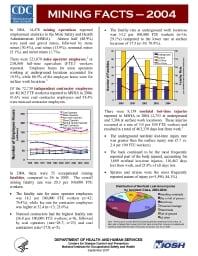Mining Publication: Mining Facts - 2004
Original creation date: September 2007
Authors: National Institute for Occupational Safety and Health
NIOSHTIC2 Number: 20032731
Pittsburgh, PA: U.S. Department of Health and Human Services, Public Health Service, Centers for Disease Control and Prevention, National Institute for Occupational Safety and Health, DHHS (NIOSH) Publication No. 2007-166, 2007 Sep; :1-2
In 2004, 14,478 mining operations reported employment statistics to the Mine Safety and Health Administration (MSHA). Almost half (48.9%) were sand and gravel mines, followed by stone mines (30.4%), coal mines (13.9%), nonmetal mines (5.1%), and metal mines (1.7%). There were 223,078 mine operator employees, or 230,860 full-time equivalent (FTE) workers reported. Employee hours for mine operators working at underground locations accounted for 19.5%, while 80.5% of the employee hours were for surface work locations. Of the 72,739 independent contractor employees (or 40,162 FTE workers) reported to MSHA in 2004, 41.6% were coal contractor employees and 58.4% were noncoal contractor employees. In 2004, there were 55 occupational mining fatalities, compared to 56 in 2003. The overall mining fatality rate was 20.3 per 100,000 FTE workers. The fatality rate for mine operator employees was 18.2 per 100,000 FTE workers (n=42; 76.4%), while the rate for contractor employees was higher at 32.4 (n=13; 23.6%). Noncoal contractors had the highest fatality rate (36.0 per 100,000 FTE workers; n=8), followed by coal operators (rate=28.7; n=23) and coal contractors (rate=27.8; n=5). The fatality rate at underground work locations was 33.2 per 100,000 FTE workers (n=16; 29.1%) compared to the lower rate at surface locations of 17.5 (n=39; 70.9%). There were 8,139 nonfatal lost-time injuries reported to MSHA in 2004 (2,753 at underground and 5,386 at surface work locations). These injuries occurred at a rate of 3.0 per 100 FTE workers and resulted in a total of 463,339 days lost from work. The underground nonfatal lost-time injury rate was greater than the surface injury rate (5.7 vs. 2.4 per 100 FTE workers). The back continued to be the most frequently reported part of the body injured, accounting for 1,699 nonfatal lost-time injuries, 110,462 days lost from work, and 23.8% of all days lost. Sprains and strains were the most frequently reported nature of injury (n=3,590; 44.1%). In 2004, 426 cases of occupational illnesses were reported to MSHA. Joint, tendon, or muscle inflammation or irritation accounted for 46.0% (n=196) of reported occupational illnesses. Mining operations reported 41 cases of black lung (coal workers' pneumoconiosis) and 7 cases of silicosis. There were 77 cases of hearing loss or impairment reported to MSHA (or 18.1% of all occupational illnesses reported).

NIOSHTIC2 Number: 20032731
Pittsburgh, PA: U.S. Department of Health and Human Services, Public Health Service, Centers for Disease Control and Prevention, National Institute for Occupational Safety and Health, DHHS (NIOSH) Publication No. 2007-166, 2007 Sep; :1-2
- Coal and metal/nonmetal mining facts - 2008
- Coal and Metal/Nonmetal Mining Facts - 2008 (HTML)
- Coal Contractor Mining Facts - 2001
- Coal Contractor Mining Facts - 2002
- Coal Contractor Mining Facts - 2003
- Coal Contractor Mining Facts - 2004
- Coal Contractor Mining Facts - 2005
- Coal Contractor Mining Facts - 2006
- Mining Fact Sheets
- Rib Falls: A Major Ground Control Issue